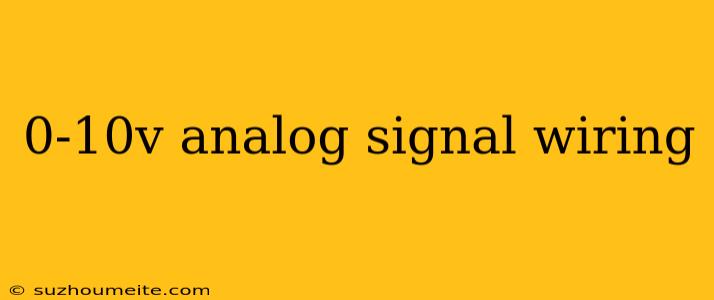Understanding 0-10V Analog Signal Wiring
Introduction
Analog signals are widely used in industrial control systems to transmit information between devices. One of the most common analog signal standards is the 0-10V signal, which is used to transmit continuous signals between devices. In this article, we will explore the basics of 0-10V analog signal wiring and how to properly connect devices using this standard.
What is a 0-10V Analog Signal?
A 0-10V analog signal is a type of analog signal that varies in voltage between 0 Volts and 10 Volts. This signal is used to transmit continuous information between devices, such as temperature, pressure, or flow rate. The 0-10V signal is widely used in industrial control systems, HVAC systems, and building automation systems.
Wiring Configuration
The wiring configuration for a 0-10V analog signal is relatively simple. The signal is transmitted between devices using a two-wire connection. The two wires are:
- Signal Wire (Positive): This wire carries the 0-10V signal and is usually marked as "+V" or "Signal+"
- Ground Wire (Negative): This wire provides a reference point for the signal and is usually marked as "-V" or "Signal-"
The signal wire is connected to the output of the transmitting device, while the ground wire is connected to the ground or common of the transmitting device. The receiving device is connected in a similar manner, with the signal wire connected to the input and the ground wire connected to the ground or common of the receiving device.
Wiring Best Practices
When wiring a 0-10V analog signal, it is essential to follow some best practices to ensure reliable signal transmission:
- Use Twisted Pair Cables: Twisted pair cables help to reduce electromagnetic interference (EMI) and ensure a more reliable signal transmission.
- Use Shielded Cables: Shielded cables provide additional protection against EMI and radio-frequency interference (RFI).
- Keep Wire Lengths Short: Keep the wire lengths as short as possible to reduce signal degradation and electromagnetic radiation.
- Avoid Parallel Wiring: Avoid wiring signals in parallel, as this can cause signal degradation and interference.
- Use Proper Connectors: Use proper connectors and wiring terminations to ensure reliable connections.
Common Applications
0-10V analog signals are widely used in various applications, including:
- Industrial Control Systems: 0-10V signals are used to transmit process variables, such as temperature, pressure, and flow rate, between devices.
- HVAC Systems: 0-10V signals are used to control heating, ventilation, and air conditioning systems.
- Building Automation Systems: 0-10V signals are used to control lighting, security, and access control systems.
Conclusion
In conclusion, 0-10V analog signal wiring is a widely used standard in industrial control systems, HVAC systems, and building automation systems. By following proper wiring configurations and best practices, you can ensure reliable signal transmission and minimize errors. Remember to use twisted pair cables, shielded cables, and proper connectors to ensure a robust and reliable signal transmission.
